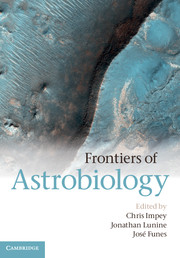Book contents
- Frontmatter
- Contents
- List of contributors
- Part I Introduction
- Inauguration of the Study Week on Astrobiology
- 1 Astrobiology – A New Synthesis
- Part II Origin of Planets and Life
- Part III History of Life on Earth
- Part IV Habitability of the Solar System
- Part V Exoplanets and Life in the Galaxy
- Index
- Plate Section
- References
1 - Astrobiology – A New Synthesis
from Part I - Introduction
Published online by Cambridge University Press: 05 December 2012
- Frontmatter
- Contents
- List of contributors
- Part I Introduction
- Inauguration of the Study Week on Astrobiology
- 1 Astrobiology – A New Synthesis
- Part II Origin of Planets and Life
- Part III History of Life on Earth
- Part IV Habitability of the Solar System
- Part V Exoplanets and Life in the Galaxy
- Index
- Plate Section
- References
Summary
Introduction
It is easy to envision our earliest ancestors, hands under chins, staring out into starlit space, wondering about their existence and how they came to be. With infinite possibilities it is no wonder that a myriad of gods could show their face in the galaxies and set the stage for the birth of religions, their theology, a moral code of ethics, a special and exclusive position for humans, and eventually a method of inquiry that has led to modern science. Furthermore, the early history of thought about life elsewhere in the universe was linked to more of a theological perception of man's relationship to gods, and Earth as the exclusive domain of life – exemplified in the thirteenth-century Aristotelian–Thomistic synthesis of science and religion.
It is particularly interesting and germane to astrobiology today, that it was astronomers, and particularly those in the fifteenth to seventeenth centuries, that were the first to make quantitative observations that questioned the orthodox view of man's place in the universe. One looked to the heavens for answers to the most profound philosophical questions and in doing so helped establish the scientific method as another method of inquiry. Perhaps a lesson from this early philosophical-based history is that the drive to grow knowledge is a fundamental and perhaps evolutionary characteristic of humans. The implication is that our survival is likely to be dependent on our exploring all possibilities that help us to understand the how, why, and uniqueness of our existence. Perhaps, no topic inspires this need to explore more than the search for life elsewhere with its implications for the origin of life and the possibility of life forms unrelated to Earth life.
- Type
- Chapter
- Information
- Frontiers of Astrobiology , pp. 5 - 22Publisher: Cambridge University PressPrint publication year: 2012



